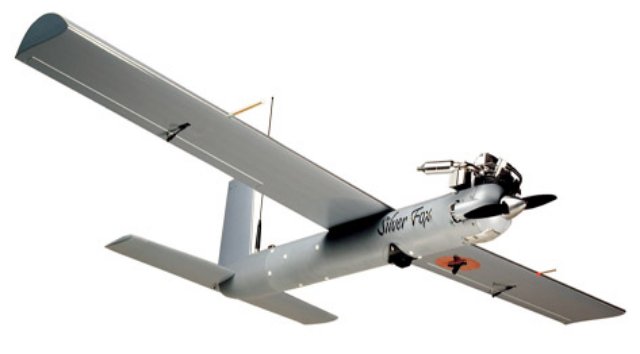While most American UAS are the under 5 kg (11 pound) micro-UAS models like Raven and Desert Hawk, there has been increasing appreciation for heavier mini-UAS. These have greater endurance, better sensors and are more resistant to high winds.
One of the more popular mini-UAS is the US Navy Silver Fox. This aircraft weighs 11.4 kg (25 pounds with a 2.2 kg/five pound payload) and can fly as 3,650 meters (12,000 feet). Its 2.4 meter (eight foot) wingspan has wings that are easily removed from the fuselage and the UAS can then be carried around in a 1.52 meter x 35 cm x 40 cm (60″x 14″ x1 5″) container. If the wind is strong enough, the Silver Fox can be launched by hand, but normally it is propelled into flight via compressed air from a portable launcher. The aircraft lands by just stopping the engine when it’s low to the ground. It is light enough to just bounce when it hits the ground.
A very quiet model aircraft engine keeps it in the air up to eight hours per sortie. The aircraft is maneuvered via radio commands via a laptop computer. It can either be controlled by the operator, or simply instructed to go from one way point to another (using an onboard GPS and flight control software.) It can fly at speeds of up to a hundred kilometers an hour (about 27 meters a second), up to 37 kilometers from the controller. It’s small enough to provide a hard to hit target for enemy troops firing at it. In any event, its engine is hard to hear when the UAS is higher than 161 meters (500 feet). At night, it’s pretty much impossible to detect from the ground. Each Silver Fox costs about $10,000.
The US Navy used Silver Fox in Iraq to support its Riverine units. But most of the Riverine missions involved some truck convoy action, and that’s where the Silver Fox is used to provide extra eyes for the sailors in the trucks.
Other users like the long duration of sorties, giving the UAS the ability to stake out an area all night, using its night vision camera. Silver Fox is also popular with scientists, as its payload is large enough to allow a wide variety of sensors to be carried, and it’s a lot cheaper than buying or renting manned aircraft.
Source: Strategy Page

